Episode #16: Nailing Email Marketing with Hyper-Personalized and Relevant Content with NetCore’s Global Product Marketing Lead Tanishq Juneja
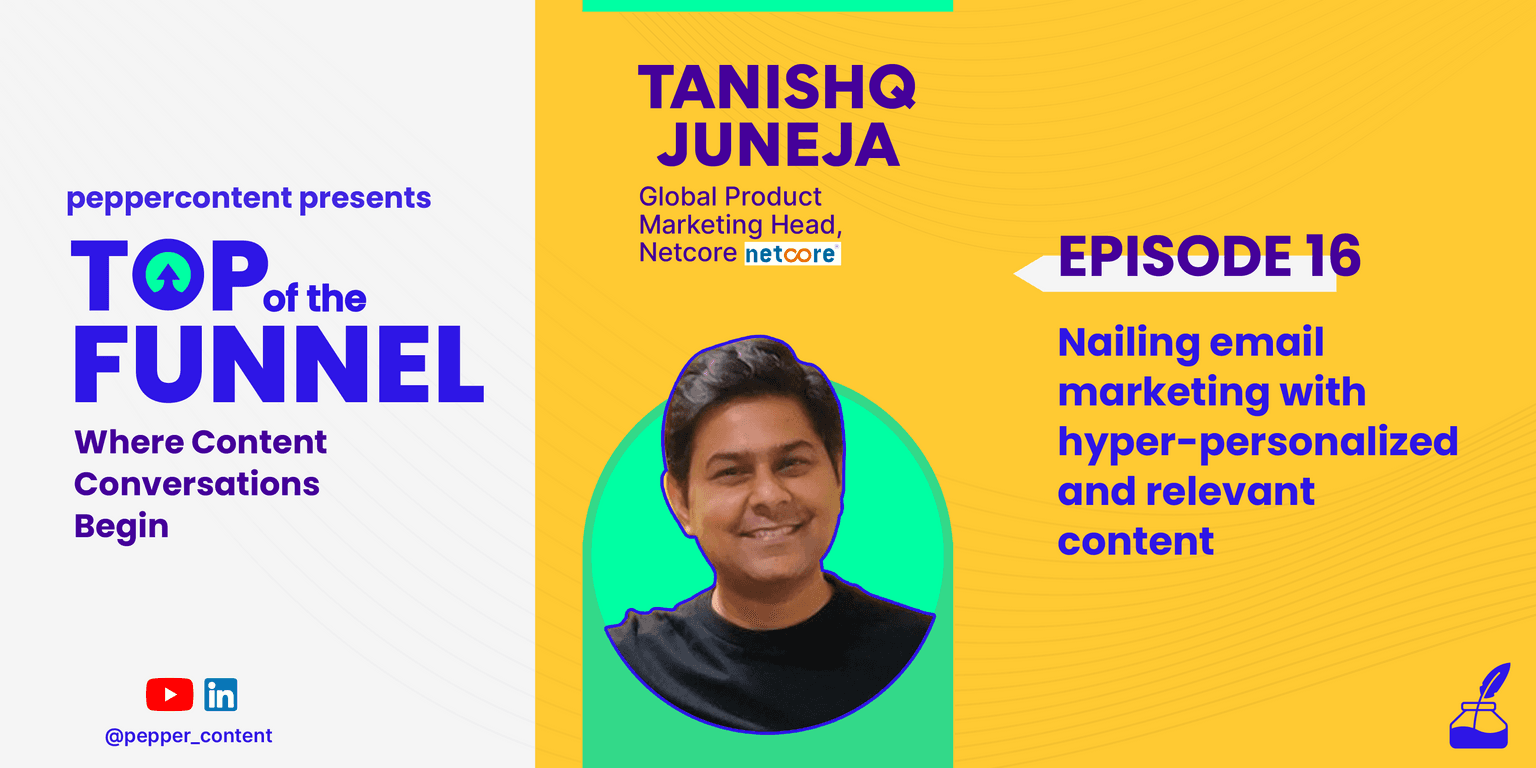
Personalized emails stand out in the customer’s inbox. They are more likely to be opened and read. It ensures that the right customer is receiving that information at the right time. It works on the principle that recipients feel special and personalized emails foster better engagement, as it creates a better rapport between the company and the consumer. Dynamic Email says that 71% of the consumers have said that a personalized experience makes them more eager to open emails. Using too many punctuations and capitals would make it look like spam.
Natasha Puri, Content Marketing Lead at Pepper Content, talks to Tanishq Juneja, Global Product Marketing Lead at NetCore about his journey to be the ‘email guy.’ NetCore Cloud is a globally recognized SaaS company, specializing in delivering Al-powered intelligent customer experiences across all aspects of the user’s journey. Tanishq Juneja has been working with NetCore Cloud for about 12 years now. He reveals the ground rules of email marketing in the following conversation and outlines his journey in how he became the go-to person for email marketing solutions.
Natasha Puri: Hello everyone. Welcome to the Top of the Funnel, the series where conversations about content begin. Our guest today is Tanishq Juneja, Global Product Marketing Lead at NetCore. Thank you for joining us here.
Tanishq Juneja: Pleased to be here.
Natasha Puri: Let us dive right into the questions. I know that this conversation is supposed to be about content. But, let us steer it more towards a masterclass on email marketing and how content marketers can use email marketing to the best of their abilities. I will start with a very basic question around content. How has the role of content developed in emails over the last couple of years? What are some trends that are here to stay? I know that you are an expert in email marketing. You have seen that evolution. Could you walk us through that journey? What would you say about the things that are constantly changing?
Tanishq Juneja: If you remember your childhood, you may remember that you received 10 to 20 emails in your inbox, wishing you a happy birthday. 10 or 15 years back, you would feel amazing. It is Natasha week. Today, it is not the case. The brands that you admire do not send you emails like that nowadays. We are marketers and consumers. So, we do not feel amazing when we receive those emails these days. We know that it is not just us, but millions of people are receiving that email. Back in those days, when my dad was worried about me not doing anything with my life, I had an account on Naukri.com. And, I showed it to my dad. I was graduating then. I would say that they have called me for an interview. It was back in my college days. As a consumer, I did not even know that they were doing email marketing. It has evolved and come a long way.
When bigger brands like Facebook emerged, they started sending emails. They sent out a lot of spam. We did not know back then.
Every email that we received, we loved it then, We did not know about the intricacies of the subject line. It was like a love letter from a brand.
Self-motivated and amazing. We received something from our brand. Now, we know that if there is a wish coming from Modi Ji, many others are receiving that email. We have now accepted the fact that it is not just us receiving an email from one person. We have grown as consumers. There are billions of emails coming out. There is a text and a technology for it. This is called email marketing. I am giving both perspectives- we are consumers and also marketers.
Brands have looked at graduating from batch and blast to now, being curious. We have a lot of content. We can send out emails. Can we do some innovations on the email along the way? There are two points- the content and data side of it. We do not like people, who purchase email addresses and then send out emails. It has improved in our country. People no longer are buying email lists, at least not openly. They are looking at subscription forms on the website. Most email commerce websites have a subscription form. You have to give a reason to your customer to come and subscribe to your website.
The process of buying or renting an email list and sending emails has improved drastically. There are three kinds of list options- single obtain, double obtain, and third is that of an email purchasing thing. We are saying a big no-no to the purchase thing because in today’s time the reputation and customer experience of one’s startup is very important from day 1 and rightly so. Single obtain is when I take Natasha’s email address and give it to Myntra for use. Double obtain is when I send your email address and they send you a confirmation email saying, ‘Hi Natasha, we received your request. Do you want to confirm this request?’ And, you will not confirm it, as you are not the one who has given the email address. There has been an evolution on the data side and the subscription side. People are trying to build that list.
On the content side, people started with very text-based emails. Sometimes, the email would have nothing but images. Then, people started doing HTML and text as a combination. Then, people graduated to images and gifs. Nowadays, people have graduated to different kinds of email, more interactive in nature. There are new technologies in place. Mailbox providers like Yahoo, Gmail, themselves do not want to use Mailbot. They are trying to create more interactive ways to engage with the users. Tech pieces like BIMY and AMP have come in email marketing in recent years. Now, you can do a lot of interaction over emails. Let me give you an example.
You, as a user, do not want to leave your mailbox to go to another website. Today, when you click on an email, you go to that website to check it out. AMP (Accelerated Mobile Pages), as a technology, is there in the email. If you want to go and browse for something, you can do it on that email. There are a lot of actions for which previously, you had to go to a landing page. Essentially, what Google is trying to say is that there are a lot of things you can do on that email. It is your space. You can keep interacting with them. The required Javascripts for video and gifs came to a while back. People started sending out interactive emails. Now, there are actions like you can fill up a form, or you can access slides, which is possible due to AMP. It is still catching up in the market. There is a lot of tech behind the AMP. That is one of the things I have seen in content, moving forward.
There are two very interesting trends that I have seen, that emerged during the pandemic. Marketers would just use email as a channel to sell. Right after the pandemic, the conversions stopped. People were not buying. They were in no position to buy. There was a drastic change in the landscape. People’s priorities changed. Marketers began to focus more on ‘conversations’, rather than ‘conversions.’ It was a grand shift from conversion to the conversation.
I want to know more about Natasha, as a brand. So, I can be more empathetic and build a connection, rather than just trying to get a transaction. The lifetime value of a user is quite high. If you stay with me as a user, I know the kind of value that I can get. Brands began to pay a lot of attention to building empathy, trust, and a connection with the user. All of that is a big change that happened in the last two years. My highest priority now is what you want to receive, not what I want to send.
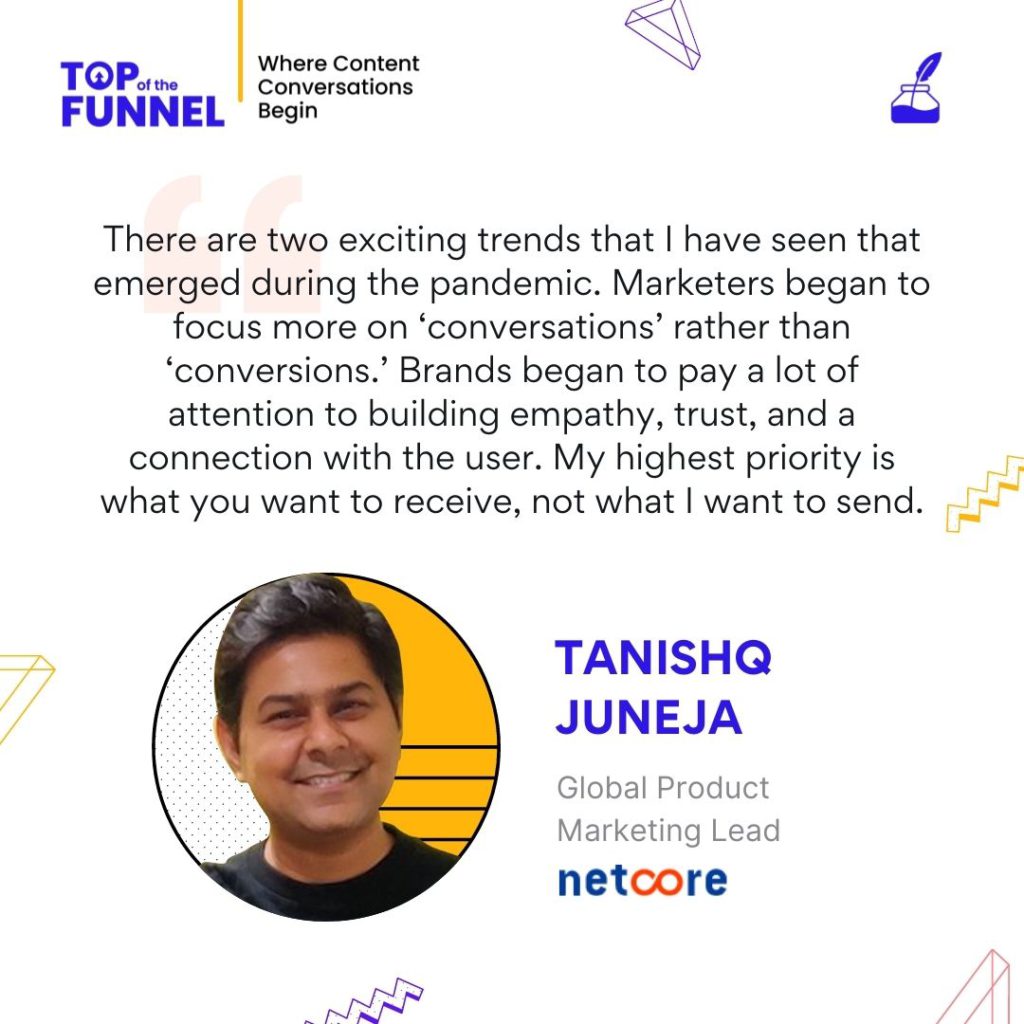
Natasha Puri: That was a great way to summarize. Now, that you mentioned it, I realize that a lot of the brands were sending content-heavy emails, which are not even talking about their products, no such CTA as such. Zomato has started sending out a newsletter with some ‘Foodie Facts’, and so on. It is a great shift.
What are some three to four growth hacks that are looking to scale their email marketing and build a subscriber’s base?
Tanishq Juneja: That is a great question. Today, email is no longer a solo channel. It is part of a larger marketing mix. Many brands can leverage email. I know that a lot of brands have turned to emails and made it their primary marketing channel because there are a lot of conversations and engagement around it. Conversion is an outcome of all these strategies.
One of the biggest things that you must do in order to scale email marketing is to have a very persuasive form on your website.
There are thousands of people coming to your website. How many of them are coming to you and subscribing to your newsletters? Are they filling up your forms? Are they convinced with the line on your persuasive form? If you just say, ‘Please subscribe to my newsletter’, people are not actually going to do it. A lot of brands innovate on that persuasive line with ‘Scratch and Win.’ They have to put their emails to get the discount vouchers.
One of the growth innovations is that you can do a lot of innovations with the traffic coming into your website. If I am coming to your website and I cannot find that persuasive form within 5 to 10 seconds, I am out, and you would lose out on lots of traffic due to that. Some brands do not pay that much attention to that subscription form. It is very important. Not everyone will come and create an account with you. You need to get their email IDs to send them something. At least, you will begin to make a connection.
The second most important thing to note is how do you create your subject line and how do you structure the beginning of your email. Brands spend maybe a week creating a great piece of content. But, they would spend only one minute writing a subject line, or maybe a few minutes. Content is the bigger chunk of the email. But, your subject line is like a teaser. So, if you create a great content piece with a great template, but your subject line is a put-off, you will lose a lot of important subscribers. How do you create a great subject line?
There is a Value and a Cost Model. We give our information to places, only where we get value from.
The moment we know each other, the exchange of information takes place. When you don’t know me, there is a mental block. Nowadays, our identity is email IDs and phone numbers. We do not want to give it out. But, the moment that we see some value out of it.
If an e-Commerce website asks for your salary or designation, you would not give it out. But, if you are opting for a fancy, Platinum Credit Card, you will willingly put your salary because you know that they are asking for it to put a limit on the credit card. You will be happy to share that information. It is a mental cost vs value model. If you are building a subject line, think of two or three subject areas that will prevent your subscribers from opening that subject line.
Say, you want to send out a loan campaign. Higher Interest Rates and Flexible EMIs are some problems. You start putting these subject lines and then, structure the subject line addressing those problems. You can say that you offer the lowest interest rate in 2021. That addresses the mental block of customers that are not willing to pay a higher interest rate. This model allows you to think of the pain areas, then you put them down. Subject lines are important. Do not spend just a few minutes, or one-tenth of your time, crafting them.
The third most important thing, that I also mentioned previously is that build meaningful conversations and not forceful says. The brands that have leveraged emails to build brand empathy, connections, and so on for the last two years are reaping the benefits. You can remember Zomato’s Health tips, or Make my Trip’s advice. There are so many great things, which brands have done in the past two years to educate and stay connected with the users. They could have just stopped sending emails since there is no transaction happening. They chose that time to get to know their users better. Brands have chosen these times to give comfort and a feeling of safety to their users with so many great campaigns.
I will never stop saying this but do not buy email lists. You stand a risk of losing all the reputation that you have built. Your emails would end up in spam.
Let me give you a bonus email hack, Natasha. Imagine that every CTA in an email is an opportunity to get engagement. Not every brand has tried this. We tried this with Lenskart a while back. There are four things on a form, name of that person, their gender, date of birth, and the ‘Submit Form’ option. There are four options to click. What we did differently was that while clicking the gender, it showed two clickable options instead of putting in the data manually. There is one less piece of information to put. If I am male, I will click on the male button. If not, I will click on the female button. In this way, we stand a chance to gain more information from the user. Every Call to Action button can be used and innovated to get more data.
If you send out an email, wanting to know which products your audience wants to buy, customize those icons and make them clickable. You will know which products are likely to be popular with your audience. The more you know about your customer, the more meaningful relationships you can build. That is one growth hack.
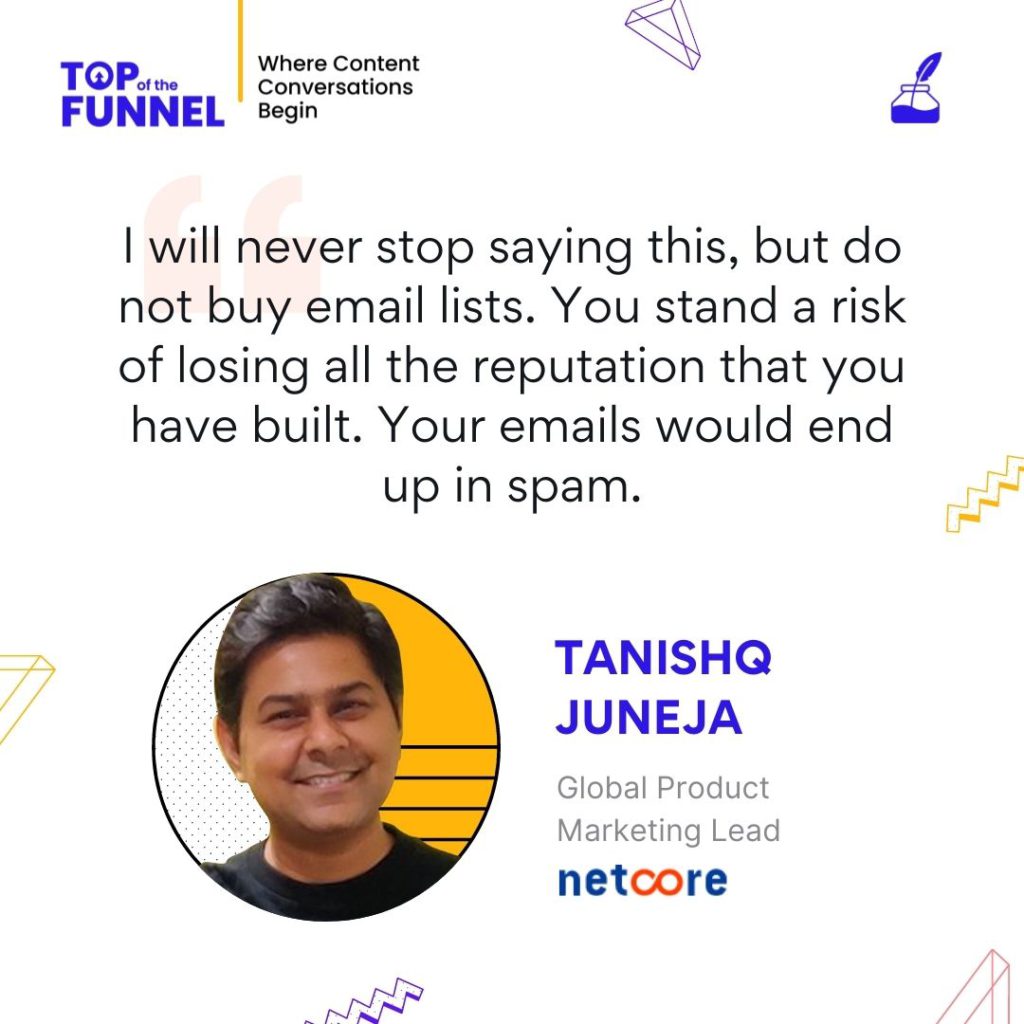
Natasha Puri: When you talk about knowing more about your audience, it sounds like a great idea. Now, when it comes to tracking those metrics, how do you do it? What are those key metrics that businesses need to track, in terms of content especially, where things are not very transactional? You mentioned that brands have been reaping the benefits for over two years. What do you think of those metrics that brands need to track to make sure that their email marketing is going somewhere and it is not just stuck?
Tanishq Juneja: If you are an online business, you have to look at the user journey. Email marketing is going to contribute to your business goals and revenue goals eventually. Where does email start? Emails start at the place where customers start subscribing to your website.
There is a welcome email program. The metrics to track your welcome email program are very different than when you are sending promotional emails. These emails are nothing but user stages could be. Some would browse and buy and become loyal customers. Some may never buy. I call these user journeys moments.
At every stage, emails present an opportunity to educate, engage, and build a meaningful connection with the user.
Emails are a visually appealing channel. It is not like a short text like SMS. Brands can use emails to carve out these moments and persuade the user at every stage.
Having said that, there are some very basic email metrics that every business should track. How many emails are you sending out? How many people are clicking on your emails? How many people are reading your emails? How many people visit your website after clicking on your email? There are drop-outs and by-clicks. Some people do not reach the website, some unsubscribe, while some people buy. These are some very important metrics. In welcome email programs, I have to track how many people willingly gave their emails to us. How many people opened our website after receiving our email? These are some leading objectives to track in welcome email programs.
In promotional emails, I have to track how many people redeemed that voucher, or how many people visited our website. Different stages with different campaign plans will have different metrics. You should not be satisfied with just having your emails opened. I also tell brands that it is very important to track your unsubscribes. We had a brand that had 20,000 people leaving them every month. But, they were happy that 50,000 new users were joining in. Net user growth remained at 30,000. After around six months, they realized 100,000 users had left them. They were okay. If the cost of retaining one user was 100 rupees, the cost of retaining 100,000 users would be a million dollars.
How did this happen? Every month, they had at least 50,000 people who had given them 50 dollars in sales. Now, the guy giving 4000 of business has left. They had unsubscribed. Brands do not pay attention to these. If Natasha has left my email list, there is still a possibility that they would remain as a customer. Gradually, the people would also leave your email list and your business. These are some of the metrics.
Natasha Puri: That was a great explanation. I know that you mentioned this before, but if you would like to collate it in one answer, what are some mistakes that brands make in email marketing?
Tanishq Juneja: As brands, we get overconfident about our email marketing and let users churn out. That is one thing. Unsubscribes are important. Brands can spend time on the guy or girl who has left the email list, but there has been some transaction. How can I get them back? Some brands have sent a cake to the users, who had unsubscribed. Some brands would go to the extent of curating a direct email from the CEO, asking them to subscribe back, telling them that they crafted the brand with a lot of love and they would want to have them back. The CEO communicating directly with the user is not exactly a one-to-one campaign. But, if the CEO of Zomato wrote to you, you would feel the warmth. You are likely to subscribe back.
We let go of inactive subscribers very easily. Say, you want me on your podcast. You send me an email, I look at it, but I ignore it. You send me another email. Seeing your persistence, I realize the value and agree. Every time, you have to innovate and make points for engagement. Whether you are in B2B or B2C, I would always recommend never to send a flat email. Forget about transactions. Emails are a way to show your personality.
You have an inactive user list of 70,000 users. You are happy with the 30% active ones. But, I would say try to pay attention to that 70% and try to convert them for as long as possible.
Again, never buy an email list. I worked with a brand that had 1 million users within a year of launch. Their website did not have much traffic. I was shocked. Those emails could be lost in spam traps. There are policing emails that check whether people are sending good emails. They send out CDS to one million users. Imagine. This can do more harm to your domain. Imagine you are being watched by anti-spam email addresses because you sent out spam. This is more harmful in today’s world. I want to give the best customer experience to my users. Reputation is very important. People buy email lists, as growing them is difficult. But, knowing the negative impacts, people should stop. Create better content or make a better form to attract users.
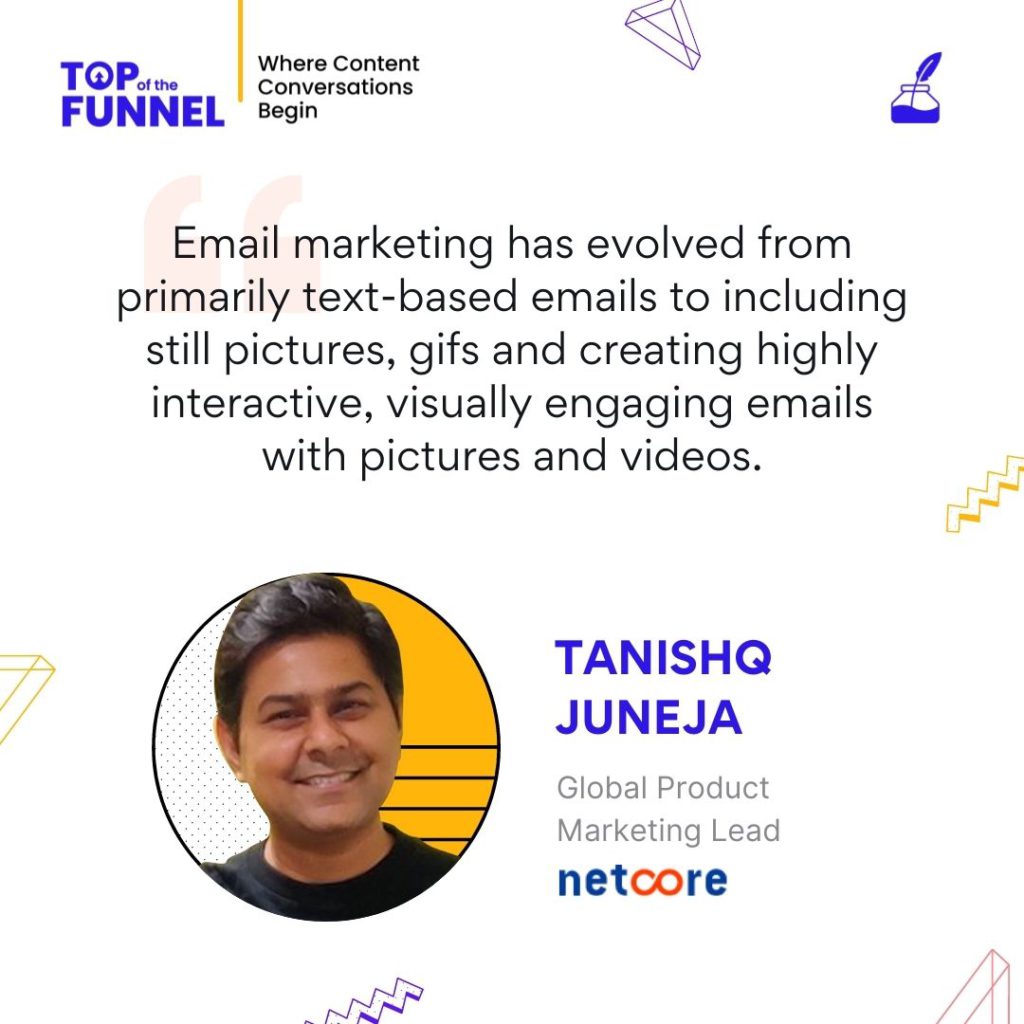
Natasha Puri: Brands reaching out and sending innovative emails, is where the power of great content comes in. It is kind of like a sales outreach. You do not want to repeat things. You want to give value to your users, maybe send them a free ebook.
Let us now talk about some great campaigns, case studies, and success stories that you would like to share.
Tanishq Juneja: Many brands are doing email marketing now because marketers have realized the importance of email’s ROI. Zomato, Phone Pe, Lenskart, Make my Trip, have done amazing campaigns in these two years. Recently, I was talking to the Head of PR and Communications of Phone Pe. During the lockdown, many apps help in payments and transactions. What kind of conversations you can create as a fintech company? Her offline team collected the locations where grocery stores were located. They collated a list of grocery stores nearby. In the initial days, this information was really hard to obtain. They tracked the locations of their users. They segmented the list and sent it.
Usually, email marketing campaigns receive engagement for about 1 or 2 days. She told me that her email was open for the next 15 days. People went back to it searching for the list of nearby grocery stores. It was a very useful campaign.
Natasha Puri: I had Priya on the show as well. She mentioned what she did during the pandemic. It was terrific to hear about.
Tanishq Juneja: Yeah, she is one marketer, who nails the email thing very well. Let me tell you about Lenskart from back in the day. People were buying their regular glasses or fashion glasses, but not their contact lenses. They had a good user base. We created an email campaign that showed what happened in Lenkart from the moment you placed an order for a glass or a contact lens. You can see the behind-the-scenes at Lenskart like they would call an ophthalmologist, how they pick out the glass, the way they would do the packing, and so on. It was a good factory review.
It said, ‘reply to us’ if you would like to add more steps. I am from that industry so, I can tell you that nobody replies to emails. This campaign got thousands of responses. They turned it into testimonials and used it for other mediums too. The response was phenomenal. I do not remember the numbers but it was a crazy 400% to 500% conversion that took place. We nominated this campaign for an international award.
Another campaign that we did for a cosmetic brand was that they promised to plant a tree for every purchase and send the Google location for that tree. It was amazing. I have no time to go and plant a tree. I would love it if a brand would plant a tree on my behalf.
Natasha Puri: We have spoken about the evolution of email marketing, the past, and the present. I want to ask you, what does the future look like? Also, from the content lens, what are the changes that may take place?
Tanishq Juneja: I think that it took a long time for email marketing to reach this place. We went from text to gifs to images. The evolution will be much faster now. I am sure that you have heard of the phrase: marketers want to send the right content to the right user at the right time. People are not able to do it. Email marketing is also learning and re-learning. We use a lot of AI.
Not to sound promotional, but NetCore has optimized AI in a way that Natasha would receive emails based on her pattern of opening emails in the past. You have a chance of opening the first two to three emails. You may not scroll below. We use it. We optimize. People are buying email lists and spamming. Our job in the future would be to put those email addresses in the customers’ inboxes. It is getting tougher. Nobody wants spam. AI will help. There will be content optimization. We might send emails to only a segment, a sample of our users in hopes of receiving a higher engagement.
Brands are looking to build experience. They should look forward to my next email campaign. If I fail on that, I will fail to create that story. Innovations will help in creating a great customer experience. AMPs will help. The relevance of interactive emails will increase. Some exceptional brands will manage to send the right and relevant content at the right time. They will make sure that the users would build conversation and look at the layout and design. Their entire experience would be amazing. The future is how AI and AMP will create hyper-personalization to create a great customer experience. Emails will draw them in.
Natasha Puri: I remember that a few years back there were talks of emails to be obsolete marketing channels soon. Who is reading emails? Our inboxes were filled. People were saying it is not important. Content has changed. You have to go beyond your normal stuff and innovate. Thank you for this amazing masterclass. There were some great learnings here. I will keep you posted. Thank you for doing this.
Tanishq Juneja: Thank you so much.
Latest Blogs
Explore how Google’s 2025 AI search updates triggered ranking chaos. Learn actionable strategies to adapt your SEO for AI Overviews, zero-click searches, and SERP volatility. Stay ahead now.
Learn how to rank on AI search engines like ChatGPT, Perplexity, and Gemini by optimizing your content for authority, structure, and relevance. Stay ahead in AI-driven search with this strategic guide.
Explore the best healthcare SEO services for your medical practice. Improve online visibility and effectively reach more patients in need of your services.
Get your hands on the latest news!
Similar Posts
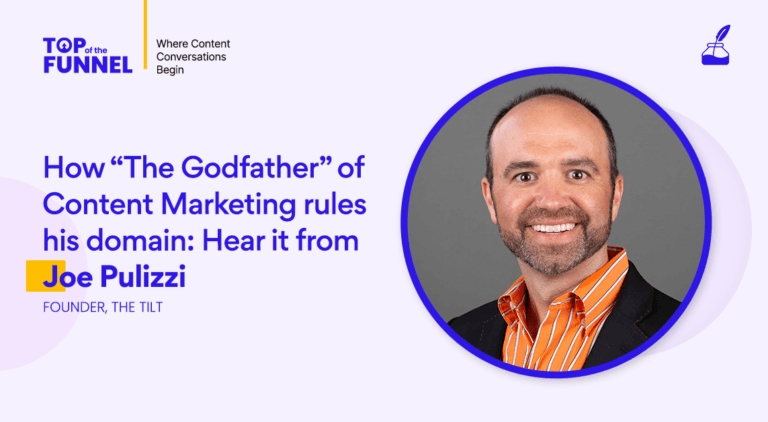
Expert Speak
18 mins read
Season 2 Episode #1 How “The Godfather” of Content Marketing Rules His Domain: Hear It From Joe Pulizzi
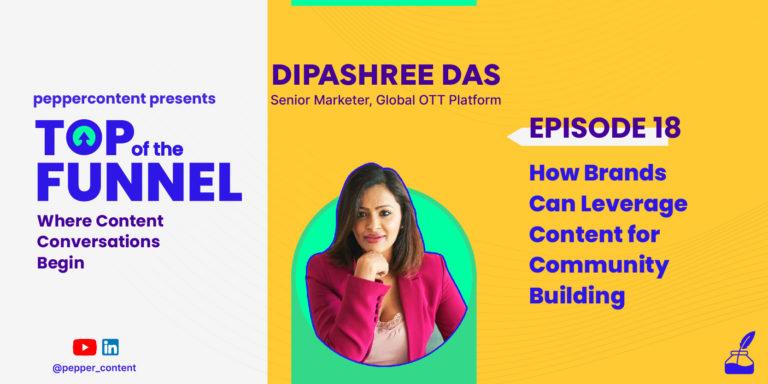
Expert Speak
16 mins read
Episode #18: How Brands Can Leverage Content for Community Building
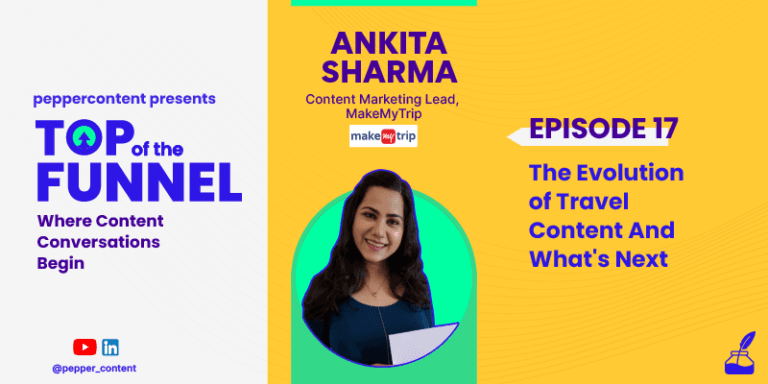
Expert Speak
11 mins read